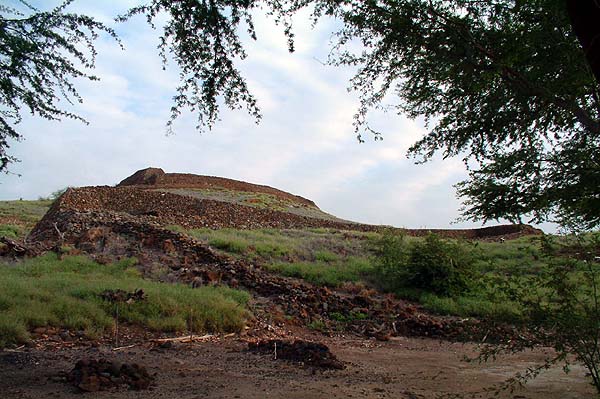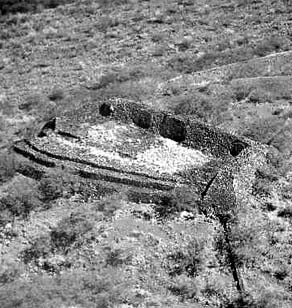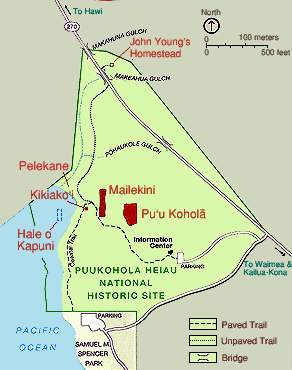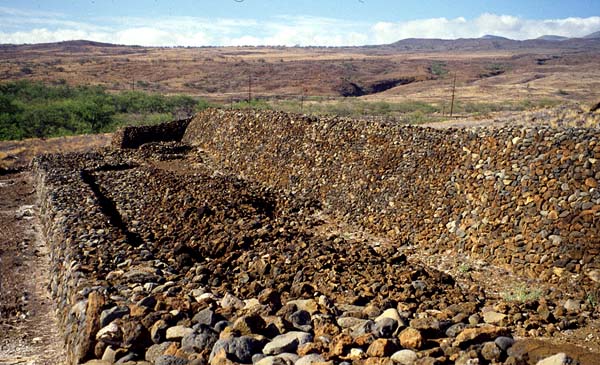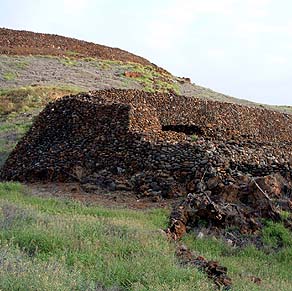 |
 |
 |
|||||
|
|
|||||||
| |
|
|
|
“It is said by some authorities that the original heiau of Pu‘u Kohola was consecrated by Lono in about 1580,” Marion writes, “and that it was rebuilt by Kamehameha about 1791, and dedicated to his war god, Kaili.” “The heiau was already in place,” Papa concurs. “But when the kahuna told Kamehameha to build this one, for him to really be successful in his vision, so that’s why he did it. Just like a test, eh? ‘If you do it, you know you’re going to make it.’ So Kamehameha, he went ahead. So that’s why that heiau is put there. But they put it around Lono. Lono is another heiau on top there, but see, nobody talks about it."
|
||
|
|
||
The story of Lono's heiau was recorded by Fornander (cited in Thrum, and in turn cited in Greene 1993): "A revolt occurred on Hawaii which had its strength in Kohala during Lonoikamakahiki's visit to Kakuhihewa's court at Oahu, which hastened his return, and landing at Kealakekua where he began gathering his forces . . . they met and routed the rebels in two battles . . . . Reinforced from Kohala and Hamakua the rebels gave two other engagements, at Puupa and Puukohala [sic], near the heiau of that name, in both of which Lono was victorious, and Kanaloakapulehu, one of the four revolting brothers, was taken prisoner, slain, and sacrificed at the heiau. Puukohola is one of several named heiaus consecrated by Lono, as acknowledgment to the gods for his victories after he had restored peace and order. This indicates that the heiau of Puukohola was in existence in the time of Lonoikamakahiki (1565-95)."
|
|
|
“According to tradition," Fornander recorded elsewhere, "Kamehameha’s work was simply one of re-construction and reconsecration to his war god Kuka‘ilimoku, for victory over his opponents, and it is a coincidence that the same deity as Kaili, Lono’s war god, presided there” (Fornander 1917 (4): 324, Footnote 1—cited in Kelly 1974: 6). Greene (1993: footnote) adds, "The details of the latter stages of this campaign, which mention that the rebels decided to encamp at Haleokapuni at Kawaihae and attempt to occupy Puukohola, from which eminence they could shower rocks down onto Lono's troops, verify the importance of this area both logistically and politically in early Hawaiian history. Instead, Lono attained the hill during the night and was able to repulse his enemies."
|
|
|
|
“It’s said that Kamehameha built the heiau there upon the advice of Kapoukahi, a kahuna kuhikuhi pu‘uone of Kaua‘i, Hannah points out. "Now 'kahuna' refers to the master of a particular discipline. Kuhikuhi, ‘to point out’; pu‘uone, ‘the sand dunes.’ Now kahuna kuhikuhi pu‘uone is often translated as a ‘temple architect.’ "But we see also throughout human history the reoccupation of sites that are sometimes abandoned because of misfortune or war, but they still have the attributes of a place like Kawaihae, with close proximity to farm lands, close proximity to forest resources and a fairly regular supply of fresh water. "If the site were abandoned at some point, the kahuna kuhikuhi pu‘uone might return to an area and see where sand dunes had developed over abandoned rock architecture." |
|
|
“So the kuhikuhi pu‘uone, besides being the architect of the temple, might have also been the one who pointed out strategic sites. And pointing out these places as desirable to re-occupy, the mana still being contained there.” “Kamehameha, when they built the rest of the heiau, they terraced that up like that," Papa adds. "Because there’s a lot of pressure, and they were good engineers. So that’s why on one side, it’s all extended. On the other side was open plain. If you sit there and look, you can see the ground going down. So what they did, they built up from this way, like a pathway in between. You see from the wall to the platform, that’s Lono.” |
|
|
|
|
Immediately below Pu‘u Kohola sits the older and smaller Mailekini heiau. "What I understand from the 19th century accounts," Hannah explains, "was that Mailekini was an older heiau which was fortified as a fort during the Kamehameha era. "So we have that notion of consecutive occupation of a site, of the mana of the utility, of the spiritual value as well as the practical applications or activities that could occur from that site." Mailekini is mentioned briefly in Kamakau's Ruling Chiefs as existing there prior to the construction of Pu‘u Kohola. British Missionary William Ellis wrote that he "visited Mairikini, another heiau, a few hundred yards nearer the shore. It was nearly equal in its dimensions to that on the summit of the hill, but inferior in every other respect. It appeared to have been literally crowded with idols, but no human sacrifices were offered to any of its gods" (Ellis 1969: 99).
|
||
|
|
||
"It has been said in some old histories of Hawai‘i Nei that the building of the heiau at Mailekini had been begun first," Desha writes. "When Hewahewa, the great kahuna in charge of preserving heiau arrived, he said to Kamehameha, 'E Kalani e, this will not secure the island for you because the house of the god is low. Lift it up high and turn it to face the sea, then from the sea will come the blessings. "Because of Hewahewa's words to Kamehameha, he agreed to commence the house of the god at this site of Pu‘ukohola, which perhaps confirms the unfinished state of Mailekini which lies to this day at a site just below Pu‘ukohola" (Desha 2000: 303-4).
|
|
|
Ii, however, writes that Kapoukahi's advice "led to the restoration of the heiau Mailekini" as well as the building of Pu‘u Kohola, indicating, again, that Mailekini was an older heiau, already in existence at the time of Kamehameha (Ii 1959: 17). "Of Mailekini heiau little of its history is learned, or what connection, if any, it had in its working with Puukohola within two hundred feet above it," wrote historian Thomas Thrum (1908: 69, cited in Greene 1993). "In early days it was said that traces of an underground passage existed, though it was difficult to tell whether or not the two temples were connected by it."
|
"The caretaker of the the Lono heiau was this man that we knew, Mahealono," Papa recounts. "He used to live here. He raised his nephew Harry, and when Harry was a young boy, he disappeared for three or four days. And so the uncle came and asked our family ‘Say, have you seen Lono?’ We say ‘No, we haven’t see him.’ "So he was getting kind of worried. He asked around, and then after one, two, three days, the boy came back. And what he had on, he had on the yellow malo. He had a pu‘olo. So the uncle looked at him and said, ‘Where did you get that?’ He took the uncle, and showed him where he went to go in—in the cave under this heiau. And so that’s why he was the caretaker. So Mahealono sealed that entrance. "A lot of people, even this guy from the Army Corps of Engineers, asked me about the cave. I said, ‘Nobody told me about it.’"
|
. |
|
|
|
| In the waters of the bay below the hill on which these heiau sit lies yet another sacred site, the heiau Hale o Kapuni.
|
||
|
|
||
|
|
|
|
|
|

|
| Kawaihae Home | Map Library | Site Map | Hawaiian Islands Home | Pacific Worlds Home |
|
|
|
|
|
|
|||
| Copyright 2006 Pacific Worlds & Associates • Usage Policy • Webmaster |
|||
